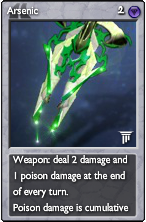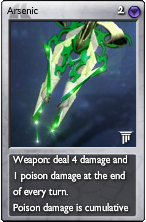I shall pick the cards of Arsenic, Skeleton, and Flesh Recluse.



Arsenic: One of the most interesting mechanics in the game so far is poison. It instantly damages the opponent at the beginning of the other player’s turn. What makes it even stronger though, is that poison damage stacks; each new infection does more damage each turn.
The card Arsenic is a dangerous, dangerous card. Compared to the other weapons, it does a small amount of damage, either 2 or 4 upgraded, but where it shines is its ability. The Arsenic card also adds 1 poison counter to the opponent. The next turn, he or she takes 1 more damage. This doesn’t seem like much, but try getting out an Arsenic on turn 1 or 2. The impact is near instantaneous. Even if Arsenic gets destroyed or stolen, it still has a lasting effect, unlike any other weapon because the poison damage is still in effect, and the poison damage isn’t affected by shields. Even a Diamond Shield equipped player will eventually fall against an upgraded Arsenic. The cost is great; 2

to play for either non-upgraded or upgraded. Its only weakness is to permanent control, like almost any other permanent, and to the rare shield that can block all its damage. If Arsenic cannot hit the opponent, a new poison counter isn’t applied.
One of the most common uses for an Arsenic is in a Speed Poison type deck, where the goal is to put as many poison counters on the opponent as fast as possible, banking on them not being able to remove the poison counters via Purify, and even then by simply doing enough to overwhelm the opponent early in the match. Arsenic fits this style perfectly; unupgraded it still does as much damage as Deadly Poison, but also can stay in the match. Other decks can use Arsenic to slowly weaken the opponent if other strategies aren’t working well; the 2

cost makes it highly affordable.



Skeleton: The Skeleton is often considered one of the weakest cards in the game. While stat wise its on par with the Photon or Ray of Light, it costs more than both at 1

. What makes the Skeleton so special is its ability to be used for almost anything, as well as its creature spam abilities.
The strength of the lowly Skeleton is in its use as basic fodder. If you need to Cremate something, why not a Skeleton? Its eligible for Butterfly Effect, suddenly turning it into a dangerous card that threatens your opponent’s entire permanent setup. Its also able to be Otyugh fodder; eating Skeletons for the benefit of a Bone Wall and/or Condor has a wonderful effect. Also, it can be mutated into something unique and powerful. The creature spam aspect cannot be ignored either. Since it is often created by a Boneyard or Graveyard, many more than 6 Skeletons can be on the field at any time. If it’s a Graveyard, and an Eclipse is in play, that’s a potential 26 Elite Skeletons with 4|3 stats. Add in Feral Bond, and that’s suddenly 26 points of healing. Two Bonds is twice as much. The potential for the Skeleton is nearly endless. Luciferace and Hope then provide a nearly impenetrable shield.
Two main deck types use Skeletons. Rainbow decks often rely heavily on creature control, and their ability to both generate and mutate Skeletons is a big boon to them. Even the creature spam aspect is welcome there. Death decks, both mono and otherwise, use Graveyards and Boneyards to product their Skeletons as well. While Death’s creature control is somewhat slow, often a Duo or Trio deck can speed this up somewhat leading to a field full of the little critters. Their usefulness is in their ability to go anywhere and fit many roles.



Flesh Recluse: The Flesh Recluse is Death’s strongest mid-level creature. Its strength lay in its low playing cost and the relatively high damage it deals, at a 1 quantum to 2 damage ratio.
The strong aspect to the Flesh Recluse is its simplicity. For 3

, this card can fit into almost any deck that uses

easily. The damage to quanta ratio is great, and the ease it can be played is better. 6 damage is enough to start hurting the opponent without appearing too dangerous. A quick swarm of these however can start truly dealing damage; 4 Flesh Recluses in play deals almost a quarter of a player’s normal health. However, the Flesh Recluse is weak against creature control, such as an early Otyugh or a Rain of Fire. This little critter hits hard, but its staying power needs to be monitored carefully.
Rush decks are most likely to take advantage of the Flesh Recluse. The speed and danger it represents is right up that archetype’s alley. The point there is to deal as much damage as possible, as fast as possible, while avoiding more costly creature control, and this is where the Flesh Recluse really shines. Any death deck can and should consider using the Flesh Recluse, and other Duo or Trio decks that use Death offensively can likely use the Flesh Recluse to good effect.

